Figure 4. Schematic illustration of two mechanisms that can lead to the generation of the sT-ag mRNA and protein. (A) Alternative RNA cis-splicing of a long pre-mRNA transcript originating from genomic SV40 DNA tandem integration; this mechanism involves two cis-splice events, i.e., a regular splice from the T-ag 5′ss to the common 3′ss and a second alternative splice from the cryptic 5′ss related to the first SV40 genome to the 3′ss related to a second SV40 DNA tandem repeat. (B) RNA trans-splicing between two early T-ag pre-mRNAs; this mechanism involves a regular cis-splice of the first transcript from the T-ag 5′ss to the common 3′ss and a second alternative trans-splice from the cryptic 5′ss of the first transcript to the 3′ss of the second transcript which is not spliced in cis. (C) Structure of the identified spliced mRNA coding for the sT-ag, which contains a 147 nt partial duplication of exon 2 sequences. Linkages between exon 1 and exon 2 sequences as well as between the exon 2 repeats resemble the splice sites and are consistent with a regular splice from the T-ag 5′ss to the common 3′ss and a second alternative splice from the cryptic 5′ss to a duplicate of the 3′ss. a and b: identical sequence stretch being duplicated in the sT-ag mRNA. (D) Structure and aa numbering of the observed 100 kD sT-ag harboring a duplication of the transforming Rb binding domain (black rectangle).

An official website of the United States government
Here's how you know
Official websites use .gov
A
.gov website belongs to an official
government organization in the United States.
Secure .gov websites use HTTPS
A lock (
) or https:// means you've safely
connected to the .gov website. Share sensitive
information only on official, secure websites.
